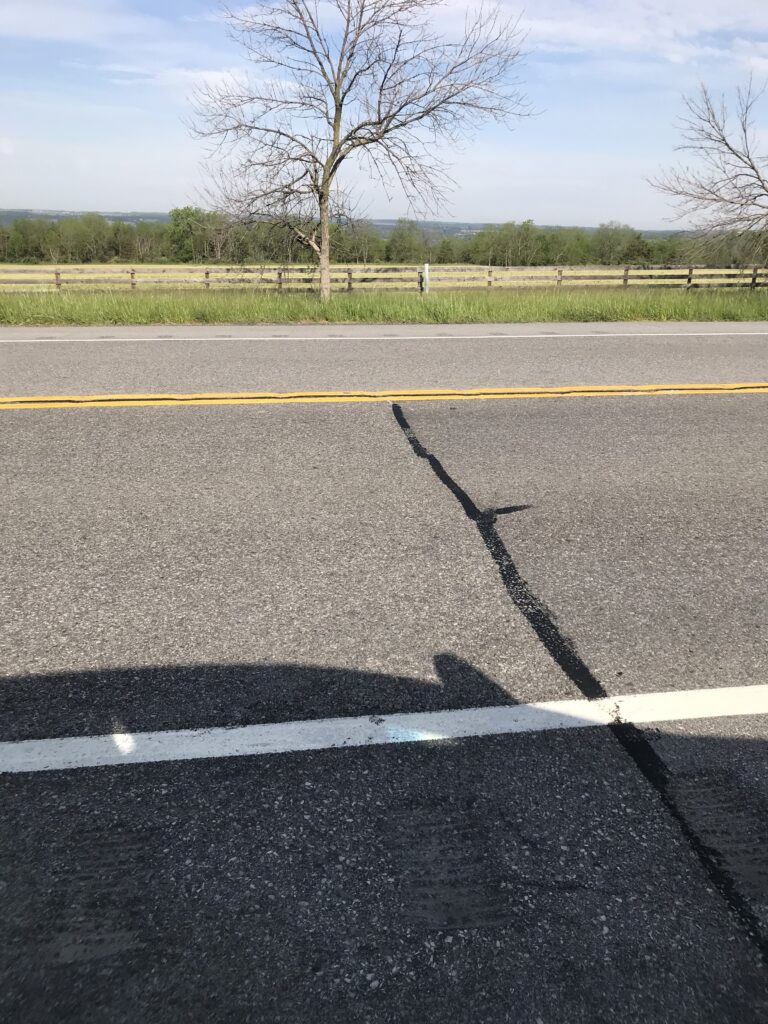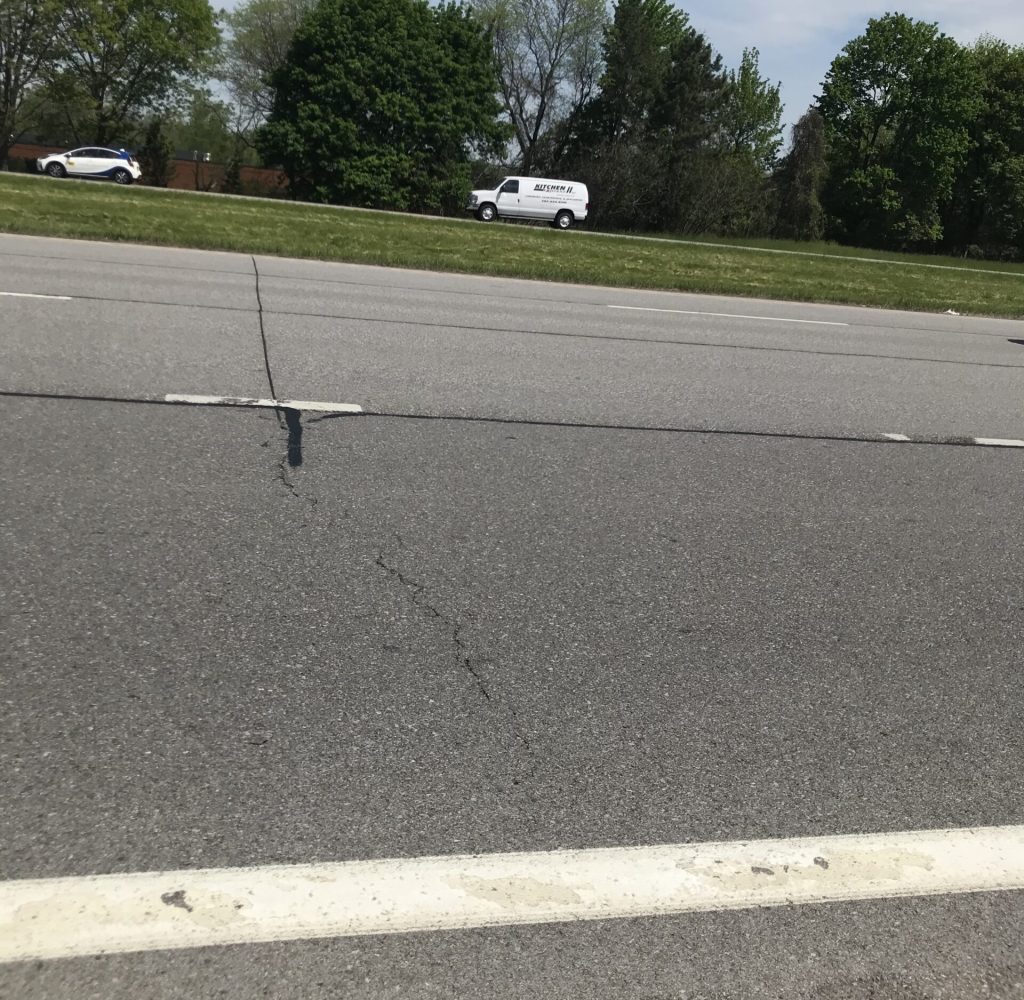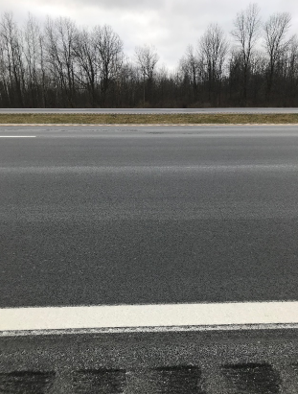The Story of New York
The Solution to Combating Composite Overlays
The Story of New York
First, what is a composite overlay?
A composite overlay is a roadway traditionally made up of reinforced cement concrete pavement (RCCP) and then topped with a layer of asphalt. In most cases, the original road was built sometime between the 1950’s – 1970’s. When first constructed, it was just a RCCP road. Over time, the roadway required rehabilitation, and this is when it would have been topped with an asphalt layer, making it a composite pavement. These composite pavements eventually fail due to base failure, cracking and other environmental distresses. Most motorists travelling on the roads are familiar with the ba-bump … ba-bump … ba-bump while driving down the interstate. This is a sure sign of deterioration and can lead to a wide array of issues for the traveling public including potholes, damaged tires and even accidents.
perpetual history of failure

There are several modes of failure when referring to pavements. The most common for a composite pavement would be reflective cracking. This happens when the joints in the old concrete pavement are unstable due to repetitive loading from truck traffic, as well as thermal contraction and expansion in areas that experience freeze thaw cycles. This instability happens most frequently when a series of joints get “locked up” and restrict movement. The roadway is designed to allow some movement, 1/8 inch at each of the joints, which is a small amount. Unfortunately, expansion and contraction doesn’t always happen at every joint like it was designed to, and instead there might be ½ inch movement at every third joint. This creates additional stress on the pavement that eventually leads to cracking. That cracking will then reflect up through the asphalt layer, creating the ba-bump, ba-bump we are all too familiar with.
Joint failure of the RCCP can also be caused by normal heavy-truck traffic. The strain that the concrete slab receives at the joint causes the base aggregates (stone) to crush and/or migrate. This can leave a small pocket under the slab, allowing additional movement of the slab. The additional movement can lead to further issues, such as waterproofing joint sealant failures. When the waterproofing fails, water penetrates and gets underneath the pavement and can cause several issues. The water infiltration will cause the load transfer bars to rust, wash-out of the base material, and pooling under the road, all which amplify the movement of the slabs. During the freeze-thaw cycles, the water freezes and expands creating an even bigger void underneath the road. What happens when nothing is left to hold the pavement at the joints? It bends and then cracks, and the once smooth ride becomes bumpy. Asphalt overlays are then used to seal the roadways and bridge the loading space at the joint locations.
the roadway to a solution
The New York State Department of Transportation (NYSDOT) has tried many methods to prevent, slow down or control the development of reflective cracking in composite overlays throughout the years. These preventative methods have been found to be very costly and ineffective, with many exhibiting fair to poor reliability and results. Some methods used include road fabrics, stress-relieving interlayers, and increased asphalt overlay thickness. None of the methods employed were delaying the onset of the reflective cracking or reducing the severity, according to Jim Jordan, former NYSDOT manager. He also noticed that secondary cracking would occur very quickly after placing the treatments. Standard transverse joint repairs, also known as Deep Joint Pavement Repairs or Pre-Overlay Treatments, proved to be the most effective remedy, but still had significant ramifications.
So, what is Deep Joint Pavement Repair?

Although it can vary from region to region in New York, the process involves milling the asphalt pavement down to the concrete pavement layer. The thickness of the overlay varies, a minimum of 4.5 inches or more is common. The first step in this process is to identify the sections of the composite pavement with reflective cracking, as well as the severity of the cracking. Medium to high level severity cracking typically requires more in-depth repairs.
For instance, State Route 383 in New York’s Region 4 required 6 inches of asphalt to be milled 6 feet wide, as well as 3 feet on each side of the crack. The 6-inch milled area is then filled with a 19mm warm mix asphalt. Once this is placed and compacted, crews would then mill down 2 inches and replace with 2 inches of a 12.5mm Superpave warm mix asphalt surface course, PG 64v-22. This process took 4 weeks of night work to complete.
Regions in New York using these repair options were looking for more cost-effective ways to complete the repairs. NYSDOT decided to use FORTA®’s synthetic asphalt fiber reinforcement, FORTA-FI® to add durability and improve crack resistance. This engineered fiber is specially formulated to reinforce all working temperatures of asphalt mixes, creating longer lasting and more resilient pavements. On State Route 383, sections of the roadway that were reinforced with FORTA-FI® did not undergo the Deep Joint Repair, instead the NYSDOT decided to try a 2 inch mill and fill using a 12.5mm Superpave warm mix asphalt surface course, PG 64s-22, with FORTA-FI® fiber reinforcement.
Benefits of skipping the costly repairs
There are many advantages to using fibers in lieu of standard joint repair. Deep Joint Repair is a very expensive operation. Repairs can cost $50-$100 per SY, plus the additional cost of Work Zone Traffic Control (WZTC). While there is a cost to add the fiber reinforcement, other changes can be made such as using a neat asphalt binder (64s-22) instead of a polymer asphalt binder (64v-22) to ease the cost of adding fibers to the asphalt mix.
Another benefit to using FORTA-FI versus the Deep Joint Repair is also a reduced risk of exposure to traffic for the agency and the contractor. By eliminating this labor-intensive repair operation, there is a reduction in equipment on the ground and reduced “open holes” while the repairs are underway, which create a hazard for motorists using the road during the repair phase.
Adding fibers has also shown to drastically reduce construction time. Typically, transverse joint repairs extend the project work by weeks, 4 weeks on State Route 383 alone. By eliminating the joint repair process, the contractor eliminates the repair time and can start the milling process and move directly into paving.
Fibers are added at the asphalt plant when the mix is being made. It is a very easy process and has zero impact on the overall asphalt production or paving operations. There are no changes needed to the Job Mix Formula (JMF) and the paving contractor doesn’t need to change or alter their paving plan. Additionally, there are no issues with hauling, paving, rolling, handwork or achieving the required compaction.
what's the return on investment

The State Route 383 project was completed with half of the job utilizing the traditional method of Deep Joint Repair, while the other half was done using FORTA-FI. The fiber is in the right line and the left lane is the control, it was paved with a traditional asphalt (no fiber added). The cost comparison between doing a Deep Joint Repair and using FORTA-FI on the State Route 383 project would have been an overall savings of 16% or $350,000 if the entire project had forgone the DJR and just used FORTA-FI fibers. Construction time could have been reduced by 4 weeks, eliminating the need for the 4 weeks of night work and traffic control. That equates to a 30% to 50% reduction in construction time.
Typical maintenance procedures for composite overlays dictate crack sealing joint repairs of the reflective cracks at just 2 years after paving. Experts have found that projects using FORTA-FI fibers are able to delay their maintenance schedules an additional 2 years due to the reinforcement capabilities of the fiber.
The expected life extension of the State Route 383 pavement has also been increased by 2 to 3 years, based on the delay of cracks and distress reduction as measured by Joe Kindler, Pavement Management Engineer/Consultant. Joe has calculated a savings of $364,000 for two extra years of pavement life on the State Route 383 project. That is roughly a 17% overall project savings based on just the extended pavement life. Total project savings is nearly 33%!

Where's the proof?
In the late 1970’s, the Army Corp of Engineers developed PAVER, a pavement management system (PMS) to maintain their own properties. Over the years, the PMS has been improved and is now used worldwide. The inspection methodology they developed is the only one with an ASTM number, D 6433. This pavement condition index survey is very accurate and repeatable when performed by knowledgeable inspectors, and rates pavements on a scale of 0-100 based on all distresses using a visual survey. This rating is used to determine when maintenance and replacement is warranted.
The process requires choosing sample areas (2,500 square feet each) amounting to approximately 10% of the total pavement inspection area. Each of these sample areas are located so that the same area will be inspected during future inspection cycles. In the sample area, every distress is mapped and listed. The severity of the distresses are recorded, as well as the quantity of each distress. This data is then input into PAVER. PAVER will then produce a Pavement Condition Index (PCI) for each sample area, which can then be extrapolated across the section to give a rating for the inspection area.
Inspecting NYDOT, District 4 - Rochester SR 383
This five-year-old pavement was inspected using the PAVER inspection methodology, to determine the current PCI of the FORTA-FI and control (no fiber) sections. Six representative sample areas were chosen on each side, six control sections and six fiber sections. The samples were 2,500 square feet in area, with the fiber sections in the right lanes. The main two distresses found were longitudinal and transverse cracking (“10”) and patching (“11“) with light (“L”) and medium (“M”) severities. There was some minor rutting (“15”) in the outside lane Northbound of the control section, in a couple of the sample areas with light (“L”) severity.
Sample FORTA-FI Side
10-L-340
10-L-290
11-M-110, 10-L-240
10-L-340
10-L-260
10-L-480
Average PCI
PCI
80
82
73
80
83
77
79
Sample Control Side
10-L-460
10-L-410, 11-L-320
10-L-370
10-L-520, 15-L-300
10-L-480, 15-L-300
10-L-340
Average PCI
PCI
77
70
79
60
61
80
71

NOW WHAT?
FORTA has conducted countless research over the years, showing the benefits that adding fibers to pavements will yield. Whether you have a parking lot or miles of interstate, FORTA-FI has been shown to save owners long-term with longer lasting pavements as well as reduced maintenance costs. For the State Route 383 project, the NYSDOT was able to save money up front by reducing Work Zone Traffic Control and time associated with the Deep Joint Repairs. Skipping the Deep Joint Repair also allows the NYDOT to utilize material resources wisely, saving the materials from being placed for the repair and removed during the paving process. The project savings could have been even greater had they used FORTA-FI reinforcement fibers on the entire project.
Using time, money and material resources wisely is something we all strive to achieve. At FORTA, our main goal is to create tougher, more durable pavements. Our products offer innovative solutions to protect and enhance the longevity of asphalt while expanding the life cycle of the pavement. Over the years, our asphalt pavement projects have been put to the test in real-world, head-to-head trial projects all over the world. NYSDOT has found a way to create longer lasting pavement while cutting project costs, increasing safety and reducing maintenance costs. Isn’t it time your state combats the issues associated with composite overlays?
